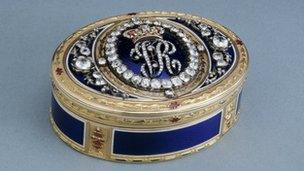Wales, Land of the Red Dragon: Chongqing exhibition
- Published
Staff have been preparing for months to send the artefacts around the world
China has long been famous for its dragons, but it will learn something of the history of another land of the dragon over the next few months.
An exhibition charting the history of Wales via some of its treasures and art is opening in Chongqing province.
Heritage Minister Huw Lewis is launching Wales, Land of the Red Dragon during a week of events further cementing links between the countries.
The exchange was about promoting Wales around the world, he said.
"We are trying very hard to raise Wales' profile right across our key economic partners, coinciding with St David's Day," Mr Lewis told BBC Wales before leaving for China on the Wales Week trade mission.
He said as well as the cultural aspects of his Far East trip, he would be undertaking "quite a heavy educational aspect" to the visit.
"Quite a number of Wales' further education colleges now have quite a mature and well-formed relationship with their Chinese equivalents, so I'll be taking a look at that too," said the minister.
"But, of course, there is the trade and economic aspect of this as well - and Wales' profile across the world is central to that.
"And an ongoing dialogue with the Chinese government in particular is central to that kind of development too."
Wales' formal links to the southern China province were initiated in 2006 when the two governments signed their first memorandum of understanding.
The agreement signed anew in 2011 commits the governments to continue working together in areas including culture and tourism. The Welsh government's main office is in Chongqing, helping businesses and organisations develop links there.

Two years ago Chongqing sent an exhibition of sandstone carvings to Wales
In 2008, National Museum Wales and the China Three Gorges Museum in Chongqing agreed to collaborate on projects
In 2011, the Chinese museum sent over a hugely successful exhibition - of ancient rock carvings from Dazu - to National Museum Wales in Cardiff, attracting more than 38,000 visitors in just two months.
Now, in return, National Museum Wales has shipped out artefacts which it says will give visitors in China a taste of the character of Wales, through its culture and language, history and landscape.
Chongqing, regarded as the gateway to western China, is home to 31 million people - more than 10 times the population of Wales - and an estimated 260,000 are expected at the Welsh exhibition.
They will view artefacts like an ancient Celtic firedog which would have stood next to the hearth in an ancient roundhouse, a gold snuff box given to explorer HM Stanley by Queen Victoria after he found Livingstone, and a porcelain tureen and dish which was made in China in about 1760, part of a dinner service for a wealthy European family.

Queen Victoria gave explorer HM Stanley, who was from Denbighshire, this snuff box to thank him for finding Livingstone in Tanzania in 1871
Andrew Renton, head of applied art at the museum, who has curated the exhibits, said he recognised the economic benefits of the countries developing economic ties.
He added: "But I would argue that there's also an important cultural dimension to this as well. From the museum's perspective we're trying to portray Wales on an international stage to raise the museum's profile internationally so those benefits are there for us."
The exhibition at Chongqing will run until the end of June and, according to the Welsh museum's director general David Anderson, it is a "wonderful way to celebrate the remarkable progress of the Wales-Chongqing link".
Mr Renton added the institutions were envisaging a long-term relationship and hoped to be able to learn a lot from each other.
- Published4 March 2013
- Published11 September 2012
- Published24 November 2011
- Published24 October 2011
- Published26 January 2011